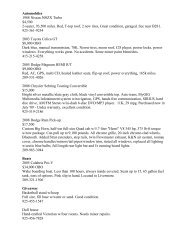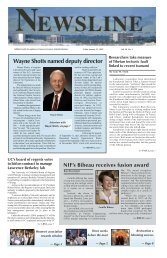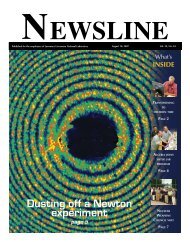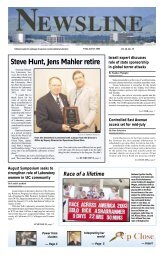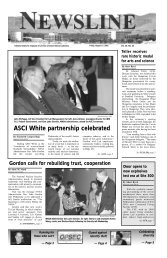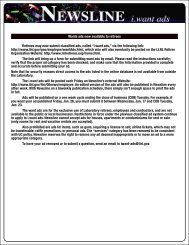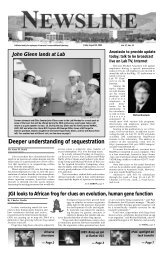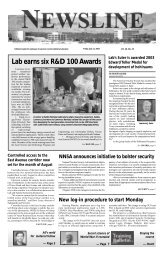American Indian Program honored - NEWSLINE - Lawrence ...
American Indian Program honored - NEWSLINE - Lawrence ...
American Indian Program honored - NEWSLINE - Lawrence ...
Create successful ePaper yourself
Turn your PDF publications into a flip-book with our unique Google optimized e-Paper software.
Friday, October 11, 2002<br />
1952 – 2002<br />
MAKING HISTORY, MAKING A DIFFERENCE<br />
This is an ongoing feature highlighting the Lab’s 50-year history. This week we take a look at the years 1991 and 1992.<br />
Inspecting for weapons of mass destruction<br />
At the end of Operation Desert Storm, the<br />
world was full of rumors about Iraq’s nuclear<br />
capabilities and how much of them remained<br />
following an intense bombing campaign. In May 1991,<br />
a specially selected team that included Laboratory<br />
engineer Bill Nelson was assembled for the first<br />
inspection of Iraqi nuclear facilities under the auspices<br />
of the United Nations Special Commission and the<br />
International Atomic Energy Agency.<br />
The inspections uncovered evidence of an<br />
advanced nuclear program, code-named Petro-<br />
Chemical Project 3, including a uranium enrichment<br />
production facility that the Iraqis attempted<br />
to hide. Perhaps the defining moment came in<br />
September 1991, when Team 6, including<br />
Laboratory physicist Cal Wood, discovered a large<br />
cache of documents. For five days, there was a<br />
standoff between the team and hundreds of heavily<br />
armed Iraqi soldiers. The group refused to leave<br />
without the papers they considered to be the smoking<br />
gun.<br />
In all, over a dozen Laboratory researchers took part in<br />
various inspections until the UN removed all personnel in<br />
1998 because of an increasingly hostile atmosphere.<br />
In 1992, Livermore’s <strong>Program</strong> for Climate Model<br />
Diagnosis and Intercomparison (PCMDI) issued the<br />
first of a continuing series of reports that would radically<br />
alter global climate change research and the way<br />
models characterize climate. PCMDI’s mission is not to<br />
make new models but rather to set a standard by which<br />
all climate models adhere, so as to lend validity to the<br />
models themselves. The need for standards in both modeling<br />
and analysis has become increasingly apparent as<br />
more complex models are developed.<br />
PCMDI has become an internationally recognized<br />
institution for climate model analysis, and its work goes<br />
beyond the nation’s borders. For example, the group is<br />
coordinating the Atmospheric Model Intercomparison<br />
Project (AMIP) on behalf of the Working Group on<br />
Numerical Experimentation of the World Climate<br />
Research <strong>Program</strong>. In this project, some 30 international<br />
modeling groups are simulating the climate of the decade<br />
1979–1988, and PCMDI is evaluating the results.<br />
Atmospheric scientists at PCMDI have also been<br />
key participants in international efforts examining the evidence<br />
for climate change due to human activities. Ben<br />
Santer, who received the prestigious MacArthur<br />
Foundation “genius award” in 1998, served as lead author<br />
for Chapter 8 (“Detection of Climate Change, and<br />
Attribution of Causes”) of the 1995 Second Assessment<br />
Report of the Intergovernmental Panel on Climate Change.<br />
Laboratory engineer Bill Nelson inspects the bombed-out reactor<br />
and nuclear research facilities at Tuwaitha (just outside of<br />
Baghdad) during the first inspection after Desert Storm.<br />
Newsline 3<br />
Better global climate models and analysis<br />
Taking advantage of terascale computer resources at Livermore,<br />
researchers successfully performed global climate simulations at a<br />
much finer resolution (50 kilometers) than ever attempted before.




